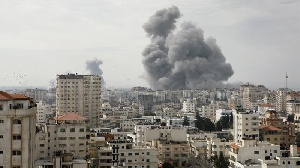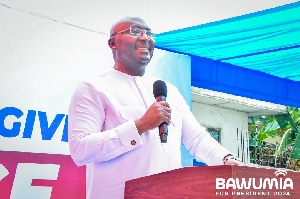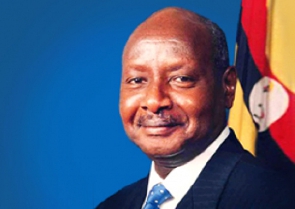Opinions of Tuesday, 7 June 2005
Columnist: GNA
Who Eliminates Child Labour in Ghana?
A GNA feature by Caesar Abagali
Tamale, June 7, GNA - On the June 12 the whole world would focus attention on child labour. This is because children have been abused, maltreated and misused by subjecting them to various inhuman treatments. But it is the use of children for various labours, which is the most pervasive and cruel even though it appears to be innocuous at times.
Statistics released by the Department of Communication and Public Information of the International Labour Organization (ILO) in Geneva indicated that some one million children worldwide between the ages of five 17 years are labouring in mining and quarrying alone.
Recent figures also compiled by the ILO, and made available to Ghana News Agency, put the overall children working under worst forms of labour worldwide at more than 246 million. More than 100 million of these children have no access to education of any kind. It is a fact that their rights are abused more often and they have no access to the Media to complain. Those who have the privilege and the opportunity to complain are punished. They are sometimes given out to serve to pay for the debts of their parents and relatives.
The theme for this year's celebration of World Day Against Child Labour (WDACL):"Digging for Survival" is, therefore, most appropriate since the children are working under harsh conditions for survival but not to plan for their future.
The use of children for menial jobs at times verging on slavery has stricken world conscience and must be considered as one of the leading human tragedies of our times, which dehumanises mankind. It raises basic human questions as to why mankind would reduce its weakest members to such degrading status without any qualms.
Who eliminates child labour from the world? It is refreshing that the world is focusing attention on mines and quarries to educate citizens on the dangers involved in mining activities. This way the rest of the world would be made to know that badly maintained mines are death traps that could collapse and kill child miners.
The rest of the world would also know and appreciate the fact that children work for long hours in mines without adequate protective equipment, with lower or no wages. They are constantly exposed to high humidity levels and extreme temperatures, thus putting their lives down as sacrificial lambs that see the knife but cannot escape its cruelty.
On June 12 the world would again see the need to at least reorient the mentality of man and do something concrete about the plight of innocent children worldwide. That would be a testimony of the wakening up of the sensitivity of mankind to issues such as the worst forms of child labour.
Here in Ghana, the focus is in the same direction and it should take the commitment of policy makers to tackle child rights issues diligently. From Akwatia to Obuasi, children are digging for diamond and gold, from Juaboso-Bia in Western Region to Tongo in the Upper East Region children are into surface mining (galamsy) for gold, while others are cracking stones at Ablekuma and Gbawe in Accra for the flourishing building industry for survival.
Beyond this, however, the existence of child labourers on the major streets as hawkers; on the rivers, lakes and sea for fishing, in the markets as porters (Kayayee) and on the farms as farm labourers cannot be denied.
However, there is the need to distinguish between child labourers and those who assist their parents or guardians in their vocation to eke out a living. For example, children accompanying their fathers to the farm to weed cannot be said to constitute child abuse.
Mr Emanuel Otoo, ILO/IPEC Official during his three-day tour to parts of the Northern Region of Ghana told the Ghana News Agency that ILO/IPEC was currently working hard with its primary constituents (governments, employers and workers) as well as other key stakeholders especially the District Assemblies and nongovernmental organisation (NGOs) to have meaningful observation of the day.
Mr Otoo said the marking of this year's WDACL would be used to create awareness of the worst forms of child labour and also to sensitise civil society to work towards a progressive elimination of child labour.
The increasing recognition of the problem in Ghana has also received a greater manifestation with its inclusion in the page two of the Ghana Poverty Reduction Strategy (1996-99) Document. This document, which represents the planning vision of the nation for the next phase of its development agenda, makes provision for the tackling of this major problem of children. Policy makers are, therefore, beginning to grapple with the issue of child labour. Another issue that has to be looked at is the problem of shepherd boys in the Northern, Upper East and Upper West Regions.
Male children are made to herd cattle. This writer had to herd the cattle of his father. They eat and drink with animals on daily basis. They walk through thorny bushes barefooted and are exposed to snake bites. They are sometimes denied the right to education. It is pathetic for one to see children as young as six years of age strapping shepherd bags and following cattle and sheep and no one seems to speak for them. Elsewhere in the West Africa Sub-Region grown up men - Fulani Herdsmen - perform the task.
Another pathetic aspect of child labour is where parents and close relatives sell children into slavery.
Here in Ghana, the magnitude of child labourers on the mines, quarries and farms cannot easily be estimated but it is indeed a painful fact and common knowledge that some children are abused.
It is indeed, sad to note that some of them die before reaching adulthood while others are left with severe physical handicaps. Because of the harrowing experiences these children go through they become emotionally traumatised and live the rest of their lives hurting. Mr Otoo pointed out that Ghana's effort at sustainable elimination of child labour would, however, have to be taken beyond mere occasional celebration.
Important as these celebrations may be it is very necessary to begin to enact legislation to punish offenders.
Again, it is important for Ghana and the rest of the world to embark on a sustained educational campaign against the menace. Policy makers owe it to their citizens and to the children, who are the victims of this enterprise, to come out with policies that would address this problem. Adequate budgetary provision should be made for the programme to eliminate child labour.
The industrialised world and other benefactors should target extreme poverty-stricken areas of the country, which constitute the main source of child labour, and sponsor projects to improve the living conditions of the people. As there is a close relationship between poverty and child labour and child trafficking.
Master Nii Nortey, a pupil at Ange's Angels School at Dzorwulu in Accra in an interview with the GNA about the celebration of WDACL said Ghanaians and for that matter parents should recognise that children had the right to be protected from exploitation and performing hazardous work so that children could grow to inherit a better world.












